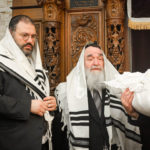The Bris Ceremony

The baby is brought in to the room, carried by the kvatter and kvatterin, usually a husband and wife, considered by many to be the godparents (this honor is often given to a childless couple, symbolizing, that they too should merit bringing a child into this world). The kvatter then gives the baby to an honored guest to place the child on the chair designated for Eliyahu Hanavi. The Mohel then recites a special prayer asking for the spirit of Eliyahu Hanavi to stand over him as he performs the Bris to perfection. The child is then lifted by another honored guest and given to the baby’s father, who then places his son on the lap of the honored Sandek. After the Mohel has performed the Bris, a special blessing is recited upon a cup of wine, and the baby is given his Jewish (Hebrew) name. During this blessing and naming, another honored guest/guests is given the honor of holding the baby. Upon the completion of the naming, the Mohel then blesses the baby for a complete and speedy recovery, the kvatter then takes the newly named baby and returns him to his mothers loving care. It is customary to serve refreshments or a meal after the Bris, and this is considered a seudat mitzvah, part of the mitzvah (Obviously all food served must be kosher). Ideally, a minyan should be present for a Bris, although this is not a pre-requisite.